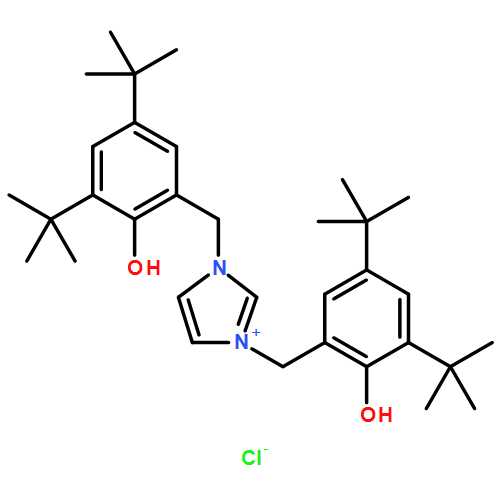Co-reporter: Hai-ning Deng, Ya-lin Xing, Cong-liang Xia, Hong-mei Sun, Qi Shen and Yong Zhang
pp: 11597-11607
Publication Date(Web):26 Jun 2012
DOI: 10.1039/C2DT30931A
A series of bis(phenol)-functionalized imidazolium salts, 1,3-bis(4,6-di-R1-2-hydroxybenzyl)-2-R2-4,5-di-R3-imidazolium chlorides H3LnCl (R1 = tBu, R2 = R3 = H, H3L1Cl, 1; R1 = CH3, R2 = R3 = H, H3L2Cl, 2; R1 = tBu, R2 = H, R3 = Cl, H3L3Cl, 3; R1 = tBu, R2 = CH3, R3 = H, H3L4Cl, 4), were used to produce a novel series of ionic iron(III) complexes [H3Ln][FeX4] (n = 1, X = Cl, 5; n = 2, X = Cl, 6; n = 3, X = Cl, 7; n = 4, X = Cl, 8; n = 1, X = Br, 9; n = 3, X = Br, 10). All of the complexes were characterized by Raman spectroscopy and electrospray ionization mass spectrometry. Elemental analysis and X-ray crystallography were also used. All of the complexes were non-hygroscopic and air-stable, with five of them existing as solids (5, 7–10) and one as an oil (6) at room temperature. A preliminary catalytic study on the cross-coupling reactions of aryl Grignard reagents with primary and secondary alkyl halides bearing β-hydrogens, revealed that all of the ionic iron(III) complexes exhibited good to excellent catalytic activity. Complexes 5, 6 and 8 exhibited optimal activity, whereas 7, 9 and 10 showed only moderate activity. Furthermore, by simply decanting the cross-coupling product in the ether layer, complexes 5 and 6 could be reused in at least seven successive runs without significant loss in catalytic activity.
Co-reporter: Hai-ning Deng, Ya-lin Xing, Cong-liang Xia, Hong-mei Sun, Qi Shen and Yong Zhang
pp: NaN11607-11607
Publication Date(Web):2012/06/26
DOI: 10.1039/C2DT30931A
A series of bis(phenol)-functionalized imidazolium salts, 1,3-bis(4,6-di-R1-2-hydroxybenzyl)-2-R2-4,5-di-R3-imidazolium chlorides H3LnCl (R1 = tBu, R2 = R3 = H, H3L1Cl, 1; R1 = CH3, R2 = R3 = H, H3L2Cl, 2; R1 = tBu, R2 = H, R3 = Cl, H3L3Cl, 3; R1 = tBu, R2 = CH3, R3 = H, H3L4Cl, 4), were used to produce a novel series of ionic iron(III) complexes [H3Ln][FeX4] (n = 1, X = Cl, 5; n = 2, X = Cl, 6; n = 3, X = Cl, 7; n = 4, X = Cl, 8; n = 1, X = Br, 9; n = 3, X = Br, 10). All of the complexes were characterized by Raman spectroscopy and electrospray ionization mass spectrometry. Elemental analysis and X-ray crystallography were also used. All of the complexes were non-hygroscopic and air-stable, with five of them existing as solids (5, 7–10) and one as an oil (6) at room temperature. A preliminary catalytic study on the cross-coupling reactions of aryl Grignard reagents with primary and secondary alkyl halides bearing β-hydrogens, revealed that all of the ionic iron(III) complexes exhibited good to excellent catalytic activity. Complexes 5, 6 and 8 exhibited optimal activity, whereas 7, 9 and 10 showed only moderate activity. Furthermore, by simply decanting the cross-coupling product in the ether layer, complexes 5 and 6 could be reused in at least seven successive runs without significant loss in catalytic activity.
